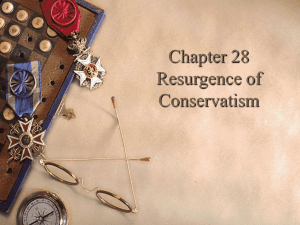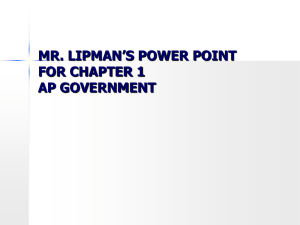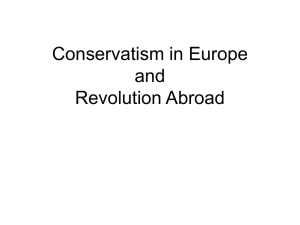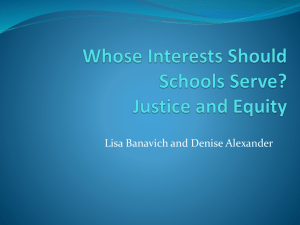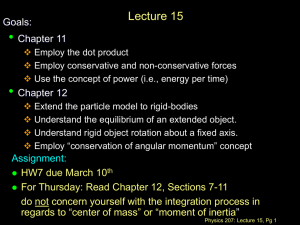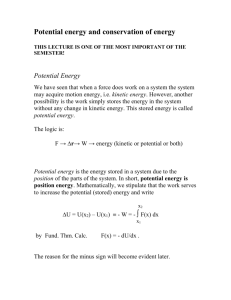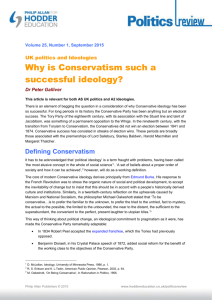Canadian Nation-Building, Communications and Culture
advertisement
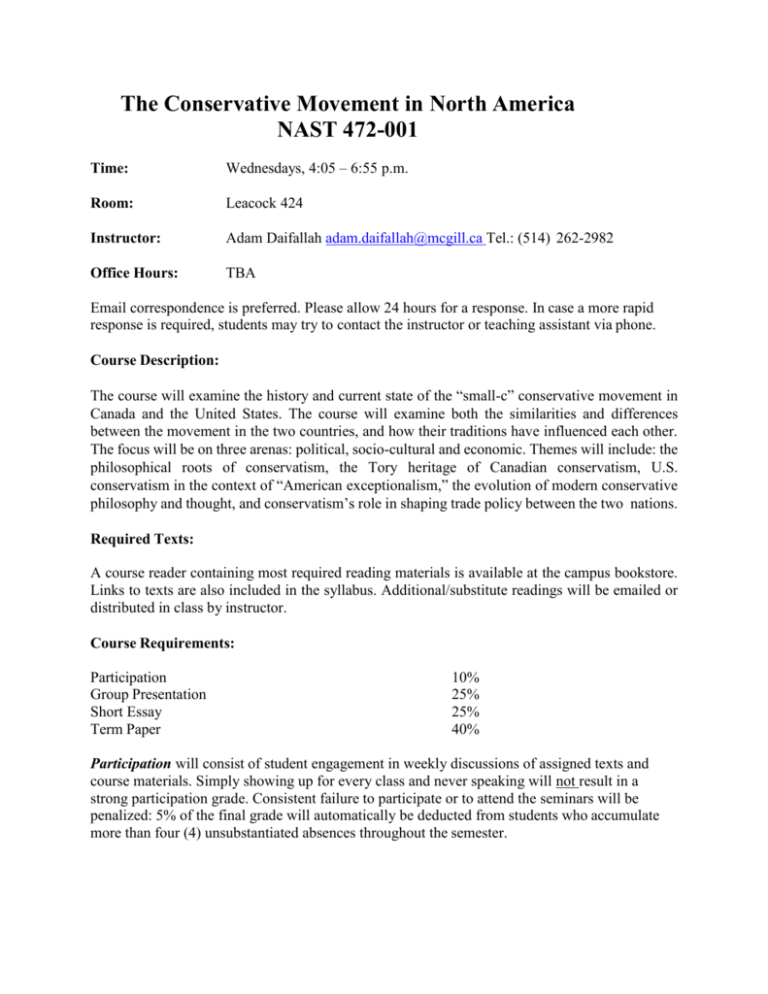
The Conservative Movement in North America NAST 472-001 Time: Wednesdays, 4:05 – 6:55 p.m. Room: Leacock 424 Instructor: Adam Daifallah adam.daifallah@mcgill.ca Tel.: (514) 262-2982 Office Hours: TBA Email correspondence is preferred. Please allow 24 hours for a response. In case a more rapid response is required, students may try to contact the instructor or teaching assistant via phone. Course Description: The course will examine the history and current state of the “small-c” conservative movement in Canada and the United States. The course will examine both the similarities and differences between the movement in the two countries, and how their traditions have influenced each other. The focus will be on three arenas: political, socio-cultural and economic. Themes will include: the philosophical roots of conservatism, the Tory heritage of Canadian conservatism, U.S. conservatism in the context of “American exceptionalism,” the evolution of modern conservative philosophy and thought, and conservatism’s role in shaping trade policy between the two nations. Required Texts: A course reader containing most required reading materials is available at the campus bookstore. Links to texts are also included in the syllabus. Additional/substitute readings will be emailed or distributed in class by instructor. Course Requirements: Participation Group Presentation Short Essay Term Paper 10% 25% 25% 40% Participation will consist of student engagement in weekly discussions of assigned texts and course materials. Simply showing up for every class and never speaking will not result in a strong participation grade. Consistent failure to participate or to attend the seminars will be penalized: 5% of the final grade will automatically be deducted from students who accumulate more than four (4) unsubstantiated absences throughout the semester. The group presentation will consist of a presentation (15 minutes long, followed by 5 - 10 minutes of questions) on one or two of the assigned weekly readings. Groups should be composed of no fewer than one (1) but no more than three (3) students. Presentations should focus on the main arguments of the readings, as well as on their rhetorical subtleties and points of controversy, thus serving as a platform for discussion. A maximum of two presentations will be held per class. Groups will be expected to sign up for the date of their presentation before the end of the second week of classes. Topic selection is on a first-come, first serve basis. Presentations will only be rescheduled in exceptional circumstances at the discretion of the instructor. The short essay will consist of a 1200 - 1500 word response to one or more of the assigned readings of any particular week. Essays should not be limited solely to summary and description. While demonstrating a strong grasp of the texts, the essay must also interrogate the argumentative premises and assumptions behind each text. Essays must be submitted electronically and send to the full class no later than 5:00 p.m. on the day before the class which discusses the relevant readings. Students will be penalized 5% per day for late short essays. Students are expected to read their colleagues’ short essays in preparation for class discussion. There will be a maximum of two essays per class, when possible. Students will be expected to sign up for their essay topic before the end of the second week of classes. Topic selection is on a first-come, first serve basis. Short essay topics will only be switched in exceptional circumstances at the discretion of the instructor. The term paper will be a standard critical response essay. As such, each essay must include elements of summary and synthesis, unified throughout by a clear thesis statement introduced in the first paragraph. The focus of the essay must be on a theme identified in class discussion, in the short essays, or in one or more of the articles/works under examination throughout the semester. The essays should begin by introducing a precise argument pertaining to a particular theme. They should then identify the central points of how the theme is addressed and interpreted in the relevant article(s) or work(s). In the remainder of the essay, students should strengthen and develop their original argument by extrapolating from the work(s) under discussion based on the student’s own argumentative insights. The goal, of course, is to convince the reader of the argument being made by way of a clear and coherent formulation and on the basis of a careful interpretation supported with specific references. Reliance on primary sources of research is strongly encouraged. Essays should be 4,000-5,000 words in length. As for documentation style, students may use whatever style they feel comfortable with (e.g. Chicago, MLA), as long as the style remains consistent throughout the entire essay. A proper cover page, page enumeration and a word count at the end are mandatory. Topic selection must be completed by the class preceding the mid-winter break (February 25) by email to the instructor and teaching assistant. The submission date for the final essay is Friday, April 10, 2015 at 4:00 p.m., after which students will be penalized 5% per day. Hard copy submissions only to the Political Science Department office, 414 Leacock, Attention: Adam Daifallah. Please note: Students, particularly graduating students, who want their grades back before summer may opt to hand in the paper no later than April 1, 2 2015 at 4:00 p.m. for early grading. Papers handed in after this date will be graded for April 30. Course Objectives The course will be presented as a mix of lectures, guest lectures and discussion. Students will: 1) Learn about the intellectual foundations of conservative thought and contributions thereto of North American conservatives. 2) Learn about the history of conservative political parties and movements in Canada and the United States. 3) Discuss the contributions these parties and movements could make to resolving public policy issues today and in the future. 4) Develop a capacity to synthesize elements of history, social theory and public policy, and formulate comprehensive yet concise arguments on this basis. McGill Statement on academic integrity: McGill University values academic integrity. As a McGill student, you are responsible for knowing the rules and regulations concerning academic honesty, which can be found in The Handbook on Student Rights and Responsibilities. Perhaps more important, it is also your responsibility to help maintain the academic integrity of the University. Cheating or plagiarizing by even one student hurts all students, because anything that undermines the evaluation process undermines the value of McGill's degrees. Therefore, carefully considered steps are taken to prevent students from cheating or plagiarizing and to catch those who do. Unfortunately, some students still resort to dishonesty, but any McGill student caught cheating or plagiarizing faces potentially serious consequences including, but not limited to, the possibility of conduct probation and a failure in the course; and such sanctions form a permanent part of the student's disciplinary record. Some students try to justify cheating or plagiarism by claiming that they are pressured to outperform their classmates in order to succeed. There are two problems with this argument: First, pressure to get good grades may explain the motivation to cheat, but it cannot justify actions that undermine the academic integrity of the University, and thereby debase the grades and degrees that students are striving for. Second, McGill does not have a policy of "weeding out" a percentage of students. Indeed, we pride ourselves on the very high quality of our incoming students. We would like everyone who is accepted to McGill to succeed academically and to graduate with a degree. In addition, there is no policy in either Arts or Science to grade students by how they rank in a class. Therefore, focus on mastering your course material, not on competing with your classmates. 3 The Conservative Movement in North America NAST 472-001 (Winter 2015) Course and Readings Schedule Boldface readings and YouTube clips are available online. All other materials are in the Coursepack or distributed by the instructor where indicated. PART I: THE CONSERVATIVE MOVEMENT IN THE U.S.A.: PHILOSOPHY AND PARTY POLITICS ► January 7th: Overview: Welcome to “The Conservative Movement in North America” The introduction will involve a description of the course outline, discussion of presentation topics and an overview of the themes and readings to be examined in the weeks ahead. Philosophical Roots of American Conservatism Charles W. Dunn and J. David Woodard. The Conservative Tradition in America. Lanham, Maryland: Rowman & Littlefield Publishers, 1996. Chapter Five, “The Historical Development of American Conservatism”, pp. 81 – 95. Stuart Gerry Brown. The First Republicans. Syracuse, NY: Syracuse University Press, 1954. Chapter One, “The Nature and Rights of Man”, pp. 1 – 17. Russell Kirk. A Program for Conservatives. Chicago: Henry Regnery Company 1954. Chapter 2, “Who Are the Conservatives?”, pp. 26-49. ► January 14th: The Birth of the Republican Party and the Civil War (readings distributed by instructor at previous class) Lewis F. Gould. Grand Old Party: A History of the Republicans. New York: Random House, 2003. “The Party of Lincoln: 1854-1865”, pp. 3-28. The Republicans, from Reconstruction to Realignment Peter H. Argersinger. “The Transformation of American Politics: Political Institutions and Public Policy” in Byron E. Shafer and Anthony J. Badger, eds., Contesting Democracy. Lawrence, Kansas: University Press of Kansas, 2001, pp. 117-131. James Reichley. The Life of the Parties. A History of American Political Parties. Lanham, Maryland: Rowman & Littlefield Publishers, Inc., 1992. “The Gilded Age” pp. 115-131. 4 ► January 21st: The Progressive Era, 1896 – 1932 Arthur Paulson. Realignment and Party Revival: Understanding American Electoral Politics at the Turn of the Twenty-First Century. Westport, CT: Praeger Publishers, 2000. Excerpt from “The Republican Party as a Bifactional System, 1896-1964”, pp. 73-83. Lewis Gould. The Presidency of Theodore Roosevelt. Lawrence, Kansas: University Press of Kansas, 1991. Excerpt from Chapter 5: ‘There’s no one like Theodore”, pp. 271-289. David Hamilton. “War on a Thousand Fronts: Herbert Hoover and the Great Depression” in Timothy Walch, ed., Uncommon Americans: The Lives and Legacies of Herbert and Lou Henry Hoover. Westport, Connecticut: Praeger Publishers, 2003, pp. 139-149. The Ike Age: Welcome to the Cold War Friedrich Hayek. The Road to Serfdom. Chicago, Illinois: The University of Chicago Press, 1994. Chapter 1, “The Abandoned Road”, pp. 13 – 21, Chapter 2 “The Great Utopia”, pp.28 – 36. Whittaker Chambers. Witness. New York: Random House Inc., 1952. Excerpt from “Foreword in the Form of a Letter to My Children”, pp. 3-12. Alan Brinkley. “A President for Certain Seasons.” Wilson Quarterly, Vol. 14 Issue 2, Spring90, p110 – 120. ► January 28th: Goldwater, Nixon, and the Politics of Race Donald S. Strong. “Further Reflections on Southern Politics”. The Journal of Politics, Vol. 33, No. 2 (May, 1971), pp. 239-256. http://links.jstor.org/sici?sici=00223816%28197105%2933%3A2%3C239%3AFROSP%3E2.0.CO%3B2-1 Barry Goldwater. The Conscience of a Conservative. New York, New York: Victor Publishing Company, Inc., 1960. Chapter Eight, “The Welfare State”, pp 70-77. Robert Mason.“I Was Going to Build a new Republican Party and a New Majority”: Richard Nixon as Party Leader, 1969–73”. Journal of American Studies, 39 (2005), 3, Cambridge University Press, pp. 463–483. Carl Bernstein and Bob Woodward, “40 years after Watergate, Nixon was far worse than we thought.” Washington Post, June 8, 2012. Conrad Black. “The War on Nixon”, National Review Online, June 14, 2012. 5 One for the Gipper: The Presidency of Ronald Reagan Davis W. Houck and Amos Kiewe, eds. Actor, Ideologue, Politician: The Public Speeches of Ronald Reagan. Westport, Connecticut: Greenwood Press, 1993. “Inaugural Address: January 20, 1981”, pp. 176 -180. Nigel Ashford. “The conservative agenda and the Reagan presidency” in Joseph Hogan, The Reagan Years: The record in Presidential leadership. Manchester: Manchester University Press, 1990, pp. 189-212. Robert M. Collins. Transforming America: Politics and Culture during the Reagan Years. New York: Columbia University Press, 2007. Excerpt from “Redefining the Political Mainstream: Reagan as a Reconstructive President”, pp. 242-250. ► February 4th: The 1990’s: Losing the White House, Taking Over Congress Ryan J. Barilleaux & Mark J. Rozell. Power and Prudence: The Presidency of George H.W. Bush. College Station: Texas A&M University Press, 2004. Excerpt from “Prudence as Public Policy: Evaluating the Bush Presidency”, pp. 114-143. Gary C. Jacobson. “The 1994 House Elections in Perspective”. Political Science Quarterly, Vol. 111, No. 2. (Summer, 1996), pp. 203-223. http://links.jstor.org/sici?sici=00323195%28199622%29111%3A2%3C203%3AT1HEIP%3E2.0.CO%3B2-0 The Bush Legacy, the 2008 and 2012 Presidential Campaigns Morris P. Fiorina. “A Divider, Not a Uniter – Did It Have to Be?” in Colin Campbell, Bert A. Rockman, Andrew Rudalevige, eds. The George W. Bush Legacy. Washington, D.C.: CQ Press, 2008, pp. 92-110. An additional article on the 2012 presidential election may be added. PART II: THE CONSERVATIVE MOVEMENT IN CANADA: PHILOSOPHY AND PARTY POLITICS ► February 11th: Philosophical Origins of Canadian Conservatism Gad Horowitz. “Conservatism, Liberalism, and Socialism in Canada: An Interpretation”, in Hugh G. Thorburn, Party Politics in Canada, Second Edition. Scarborough: Prentice-Hall of Canada, 1967, pp. 55-65. Speech by Sir John A. Macdonald to the Workingmen’s Liberal Conservative Association of Ottawa and Le Cercle Lafontaine, Delivered in Ottawa on the 8th day of October, 1886. George Hogan. The Conservative in Canada. Toronto: McLelland and Stewart Limited, 1963. Chapter 1, “The Progressive Conservative Tradition,” pp. 1-20. 6 Brian Lee Crowley. Fearful Symmetry. Toronto: Key Porter Books, 2009. Chapter 2, “Our Forgotten Political Tradition Vindicated”, pp. 43-65. Confederation and the Influence of Sir John A. Macdonald George Hogan. The Conservative in Canada. Toronto: McLelland and Stewart Limited, 1963. Chapter 1, “The Progressive Conservative Attitude,” pp. 21-32. Richard Gwyn, John A: The Man Who Made Us. United States of America: Random House Canada, 2007. Chapter 22, “The Man of the Conference”, pp. 390 – 405. ► February 18th: Protectionism, Love of Empire, and Canada’s New Deal Liberal-Conservative Association, 1911. The Liberal-Conservative handbook, 1911, a consideration of reciprocity and an exposition of the policy of the Liberal-Conservative Party, with statement of some extravagant and improper transaction of the Laurier administration in recent years. “The Reciprocity Agreement”, pp.131-139. Michael Bliss. Right Honorable Men: The Descent of Canadian Politics from Macdonald to Mulroney, Toronto: Harper Collins, 1994. Chapter 4, “Meighen and Bennett: The Crisis of the Self-Made Leader”, pp. 93 – 94, 98 – 100, 107 – 119. From Populists to Socialists?: John Diefenbaker, George Grant, and the Rise of the Red Tory Michael Bliss. Right Honorable Men: The Descent of Canadian Politics from Macdonald to Mulroney, Toronto: Harper Collins, 1994. Chapter 7, “Diefenbaker: Trying Tory Populism”, pp. 189-201, 205-212. George Grant. Lament for a Nation. Carleton University Press, 1994, Chapter 6, pp. 81-97. ► February 25h: Conservatism in a Time of Crisis: From Separatists to Stagflation Geoffrey Stevens. Stanfield. Toronto: McClelland & Stewart, 1976. Chapter 11, “And Now, Pierre Trudeau (1967-1968)”, pp. 215 – 221. Jeffrey Simpson. Discipline of Power: The Conservative Interlude and the Liberal Restoration. Personal Library, 1980. Chapter 2, “Roots of Policy”, pp. 49-56, Chapter 8, “The New Economic Catechism”, pp. 211 – 231. Peter Brimelow. The Patriot Game: National Dreams and Political Realities. Toronto: Key Porter Books Limited, 1986. Chapter 4, “The World the Liberals Made”, pp. 43-53. The Mulroney Era: Free Trade Victory, Constitutional Quagmires, and the Collapse of the Big Tent 7 Tasha Kheiriddin and Adam Daifallah. Rescuing Canada’s Right: Blueprint for a Conservative Revolution. Mississauga: John Wiley and Sons Canada, Ltd., 2005. Chapter 2, “It was the Best of Times, It was the Worst of Times: Mulroney, Manning and Bouchard,” pp. 15-28. (distrib. by instructor) David Frum. What’s Right: The New Conservatism and What it Means for Canada. Toronto: Random House Inc., 1996. “Double Dealing”, pp. 193-206. Andrew Cohen, A Deal Undone: The Making and the Breaking of the Meech Lake Accord, Vancouver, Douglas and McIntyre. Chapter 10, “A Roll of the Dice”, pp. 218-232. PART III: THE CONSERVATIVE MOVEMENT IN NORTH AMERICA: EXTRA-POLITICAL ACTORS AND MAJOR POLICY ISSUES ► March 11th: From Ashes to Victory: Stephen Harper, the Rebuilding of the Conservative Party Bob Plamondon. Full Circle: Death and Resurrection in Canadian Conservative Politics. Toronto: Key Porter, 2006. Chapter 12, “The Merger”, pp. 306-320. Hugh Segal. The Long Road Back: The Conservative Journey, 1993-2006. Toronto: Harper Collins Canada, 2006. Chapter 15, “Minority, Discipline, and Choice”, pp. 187-197. Tom Flanagan. Harper’s Team: Behind the Scenes in the Conservative Rise to Power. Canada: McGill-Queen’s University Press, 2007. Chapter 9, “The Ten Commandments of Conservative Campaigning”, pp. 274-290. A reading on the 2011 Canadian federal election campaign may be added. The State of the Current Government and Scaling the Towers of Academe: The State of Conservatism on Campus Jan Narveson. "It is essential to support free speech, BUT it must be exercised responsibly." Symposium contribution to the annual meeting of the Society for Academic Freedom and Scholarship (SAFS), University of Western Ontario, May 13, 2006. http://www.safs.ca/narvesontalk.html Robert Maranto. “As a Republican, I'm on the Fringe”. Washington Post, Sunday, December 9, 2007, B01. http://www.washingtonpost.com/wpdyn/content/article/2007/12/07/AR2007120701618_pf.html FOX News interview with Evan Coyne Maloney, director of Indoctrinate U: http://www.youtube.com/watch?v=OM6mIMij5IY 8 ► March 18th: Think Tanks and Interest Groups: Why Canada Leaned Left while the U.S.A. Went Right Leslie A. Pal. Interests of State: The Politics of Language, Multiculturalism, and Feminism in Canada. Montreal: McGill-Queen’s University Press, 1993. Chapter 5, “The Rise and Fall of “Citizen Participation”: 1968-1974, pp. 101-123. John Mickelthwait and Adrian Woolridge. The Right Nation: Conservative Power in America. New York, New York: Penguin Press, 2004. Excerpts from “The Agony of Liberalism, 19641988”, pp. 76-81, 155-161, 168-171. Lewis F. Powell, Jr., “Confidential Memorandum: Attack of American Free Enterprise System”, August 23, 1971, U.S. Chamber of Commerce. http://law.wlu.edu/deptimages/Powell%20Archives/PowellMemorandumTypescript.pdf The Justice System: A Conservative Challenge Tasha Kheiriddin and Adam Daifallah. Rescuing Canada’s Right: Blueprint for a Conservative Revolution. Mississauga: John Wiley and Sons Canada, Ltd., 2005. Chapter 7, “Call in the Lawyers!: Can Conservatives Make Friends with the Charter?”, pp. 99-117. Transcript of National Press Club Luncheon with Robert Bork, “Nomination of John Roberts To U.S. Supreme Court”, Tuesday, September 6, 2005. http://hfm.cffss.org/files/publications/natl_press_club_bork.pdf An article on the U.S. Supreme Court nomination process may be added to or substituted for the above reading. ► March 25th: Foreign Policy: Conservatives in the Age of Terror Dinesh D’Souza. The Enemy at Home: The Cultural Left and Its Responsibility for 9/11. New York: Doubleday, 2007. “Emboldening the Enemy: How Liberal Foreign Policy Produced American Vulnerability”, 204–226. Sean M. Maloney. “Canada, Afghanistan, and the Blame Game”. Policy Options, DecemberJanuary 2006, pp. 21-27. http://policyoptions.irpp.org/issues/afghanistan-2/canadaafghanistan-and-the-blame-game/ An article on the war in Afghanistan may be added. Organized Religion: Rise of the Theocons Andrew Sullivan. The Conservative Soul: How We Lost It, How to Get It Back. New York: HarperCollins Publishers, 2006. Excerpts from “The Bush Crucible”, pp. 133 – 147, 151 -157. An additional reading may be chosen by instructor. 9 ► April 1st: The Environment: Market-Driven vs. State-Driven Environmental Policies Robert D. Sopuck, “Smart and Green: An Environmental Policy for the 21st Century,” Frontier Centre for Public Policy Series, No.25, October 2005, pp. 1-13. http://www.fcpp.org/images/publications/PolicySeries25SmartandGreenOct2005.pdf Peter W. Huber. Hard Green: saving the environment from the environmentalists: a conservative manifesto. New York: Basic Books, 1999. “A conservative environmental manifesto”, pp. 195204. An additional reading may be added, to be distributed in the previous class. The Mass Media: Conservatives’ Friend or Foe? Tasha Kheiriddin and Adam Daifallah. Rescuing Canada’s Right: Blueprint for a Conservative Revolution. Mississauga: John Wiley and Sons Canada, Ltd., 2005. Chapter 6, “Rebalancing the Media: Image is (Almost) Everything”, pp. 83-98. Brian C. Anderson. South Park Conservatives: The Revolt against Liberal Media Bias. Washington DC: Regnery Publishing, 2005. Excerpts from “Fighting Back: Conservative Talk Radio”, “The FOX Effect”, “South Park Anti-Liberals”, pp. 33-45, 55-61, 75-80. An additional reading may be added, to be distributed in the previous class. ►April 8th: The Economy: Policy as Identity in the U.S. William Watson. Globalization and the Meaning of Canadian Life. Toronto: University of Toronto Press, 1998. Chapter 5, “Home Truths” pp. 38-45, and Chapter 13, “Canadian Free Enterprise”, pp. 121-128. Arnon Gutfeld. American Exceptionalism: The Effects of Plenty on the American Experience. Portland, Oregon: Sussex Academic Press, 2002. “Steinmo’s Thesis: is America’s Limited Welfare State Policy a Matter of Conservative Ideology?” pp. 46 – 54. Rod Dreher. Crunchy Cons: The New Conservative Counterculture and Its Return to Roots. New York: Three Rivers Press, 2006. Chapter 2, “Consumerism”, pp. 27 – 55. An article on the 2008-2009 financial crisis may be added, to be distributed in the previous class. Canada and Immigration: The Next Challenge for Conservatives Tasha Kheiriddin and Adam Daifallah. Rescuing Canada’s Right: Blueprint for a Conservative Revolution. Mississauga: John Wiley and Sons Canada, Ltd., 2005. Chapter 10, “Connecting with New Canadians,” pp. 155-170. An article analyzing the immigrant vote in the 2011 election may be added. 10
